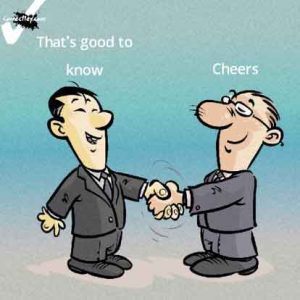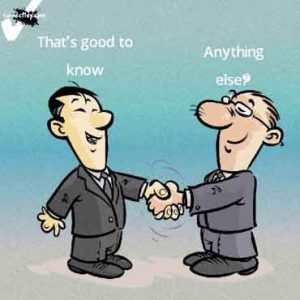There are several clauses that happen to end conversations only because the person being referred to has no idea of how to respond. Some clauses do not need a response, however. That’s good to know.
When a person says That’s good to know, how do you respond? This statement is said when you have shared the info with a person or you are talking about something you both just discovered.
You have probably heard this once or twice in a conversation that does not include any important information. That is because some people say this clause when they have nothing to say.
If you don’t think the conversation has to end there, you are probably right. Below is a list of possible responses you can give to That’s good to know.
16 Great Responses to That’s Good to Know
Thank you
When a person says That’s good to know, you can simply say Thank you. It is important to know that, most of the time, this clause is said when the conversation is about to end. 90% of the time, this clause ends the conversation.
There is no perfect response to give in this case. There is a high chance that the person who said this clause is intentional about ending the conversation.
If you feel like you are forced to just say something, you can say Thank you. Forget about getting a response from him/her. If the person is willing to continue the conversation, the topic will change.
If you really want to continue talking, you can change the topic yourself. The point is the clause (That is good to know) has marked the end of that topic. Thank you is not the perfect response but it’s something you can say.
However, Thank you is an okay response if That’s good to know was said as a compliment. You may have mentioned something about yourself. It could be a part of you or an achievement.
If the person says, That’s good to know, you can reply with Thank you. The topic will also change from there.
Didn’t you know?
When you say That’s good to know after getting information from a person, you can be replied with this question. This question implies that the person didn’t mean to pass on information. Rather, he/she was thinking of discussing the information.
When you say That’s good to know, it tells the person that you didn’t know about the information. If the person was intending to inform you about something, then this question won’t be asked.
You could also give this response if a person comes to give you the information that he/she just received. The person can excitedly mention that the information is good to know.
This response implies that you already knew about it. It could be a joke, however. The person could ask if you already knew about it, then you can say you didn’t know either.
You mean Great
When a person says That’s good to know, you can respond by saying You mean Great.
A person can say That’s good to know if you share some happy news with him/her. By responding with this, you are showing that you are very excited about the information. The information is not just good to know but Great to know.
This has to be a response to happy news, however. If the other person does not find the information exciting, it will seem weird to see you jubilating about it.
Nice to meet you
When a person says That’s good to know, you can say Nice to meet you. This response does not fit into all situations.
The majority of the time you hear That’s good to know is when a person does not know what more to say about a particular topic. This is why it is common for strangers to say That’s good to know while introducing themselves to each other.
They can say this compliment after one person talks about a part of himself or herself. Once this is said, the topic probably changes or the person says more about the compliment part of himself or herself.
When an acquaintance says That’s good to know and the conversation looks like it’s going to end soon, you can say Nice to meet you. That ends the conversation anyway. A better alternative to keep the conversation going is to ask a question.
I know, right?
When a person says That’s good to know, you can give this response. This response is most commonly used in texts. It is abbreviated as IKR.
This will work better if you are responding to a text. This expression is used when a person states a fact that you agree with. You can say I know, right? It shows that you think the person is right.
You can share information that seems exciting to you with a person. If the person responds with That’s good to know and appears to be equally excited, you can say I know, right?
It implies that you know the value of the information too and you agree that it is good to know.
It’s my pleasure

When a person says That’s good to know, you can respond by saying It’s my pleasure. This is not the best response in all contexts but it is an honest one. You can say this when you share information with a person.
When a person reacts to exciting information with That’s good to know, there is a high chance that the conversation is not coming to an end immediately. You can see that when the person continues to talk about the information.
When you get exciting information, it only remains exciting for a moment. After a while, you will be calm about it. When you share the information with someone, the person can reply excitedly but you will be calm.
If the person excitedly says That’s good to know, you can respond with It’s my pleasure. There is a high chance the person will ask more questions and keep talking about it.
However, the person can also say That’s good to know with less excitement. You can still respond with this but the conversation will most likely end there.
Right. It’s nice to know
When a person says That’s good to know, you can respond by acknowledging that it is nice to know.
When you share information with a person, he/she may respond that it is good to know. If the person is excited about it, the conversation may continue.
However, if the person looks slightly carefree with the way he/she says That is good to know, you shouldn’t show your excitement either. You can simply say it’s nice to know.
There are some cases where the information is not actually exciting. However, the person says it’s good to know because he/she cannot think of any other response. You can simply respond by saying this with the same energy.
Cheers

When a person says That’s good to know, you can respond by saying Cheers. This should be used in a truly exciting situation.
It is normal to share exciting information without acting extremely excited about it. If a person reacts to good information by saying That’s good to know, a mature response you can give is Cheers.
Cheers has several meanings. In this case, it means Congratulations. It is a word that is said when people are celebrating an achievement. It can also be used to make toast.
Same here
When a person says That’s good to know, you can say Same here. It is a very boring response but it is just okay if the person appears boring too.
You can share exciting information and expect a happy reaction but get a boring one. You may feel stupid to continue showing your excitement so, instead of doing that, you just give back the same energy.
Undoubtedly, you will get tired of trying to force a conversation with the person. Giving this short response shows that you don’t care about the conversation anymore.
I’m happy too
When a person says That’s good to know, you can say how happy you are about the same thing. When you share information with a person, you may get a sincerely excited reaction.
However, there are cases where you are not interested in jubilating. Instead of appearing boring, you can wear an exciting smile so the person doesn’t feel like he/she is forcing you to have a conversation.
When you use this response, use an equally excited tone and wear a smile unless the person is not looking excited about the news either.
You’re welcome
When a person says That’s good to know, you can respond by saying You are welcome.
When a person reacts to exciting information with That’s good to know, there is a high chance that the conversation is not coming to an end immediately. You can see that when the person continues to talk about the information.
When you get exciting information, it only remains exciting for a moment. After a while, you will be calm about it. When you share the information with someone, the person can reply excitedly but you will be calm.
If the person excitedly says, That’s good to know, you can respond with You’re welcome. There is a high chance the person will ask more questions and keep talking about it.
Sure it is
When a person says That’s good to know, you can respond with Sure it is. It is another boring response. However, it is okay to say this if the person appears boring too.
You can share exciting information and expect a happy reaction but get a boring one. It’s normal to feel stupid to continue showing your excitement so, instead of doing that, you should just give back the same energy.
Undoubtedly, you will get tired of trying to force a conversation with the person. This short response shows that you don’t care about the conversation anymore.
Anything else?

When a person says That’s good to know, you can ask if there is anything else you can help with.
This clause is often said by an acquaintance after you helped with important information. If the person says That’s good to know, there is a high chance the conversation will end there unless one of you asks a question. You can ask if there is Anything else.
I’d get me something sweet if I were you
When a person says That’s good to know, you can joke with the person by saying this. After helping a person with information or sharing exciting news, if the person shows some excitement and says That’s good to know, you can give this response.
This may help you continue the conversation.
Yes, and we like good things
This is another humorous response you can give. When you share some good news, a person can reply with That’s good to know.
The person can show excitement with his/her voice but without showing it on the face. It could also be shown on the face but not in the voice.
When you give this response, the person will most likely smile about it. This doesn’t guarantee that the conversation will continue, however.
Do you think so?
You can say this if you share information that seems normal to you but get a reaction of excitement from someone. The person can say, That’s good to know while showing so much excitement.
If you don’t see why the person is so excited, you can say this. Also, if you think it is bad news and the person says That’s good to know (even without showing excitement), you can say this.
Conclusion
This clause ends conversations 90% of the time but it doesn’t have to. If you want the conversation to continue, some responses in the list above are there to help you out. Some responses do not keep the conversation going, however.
To drag the conversation for a short while, you can employ some funny responses or questions from the list. Some of them may even lead to a new conversation. That is good to know, right?